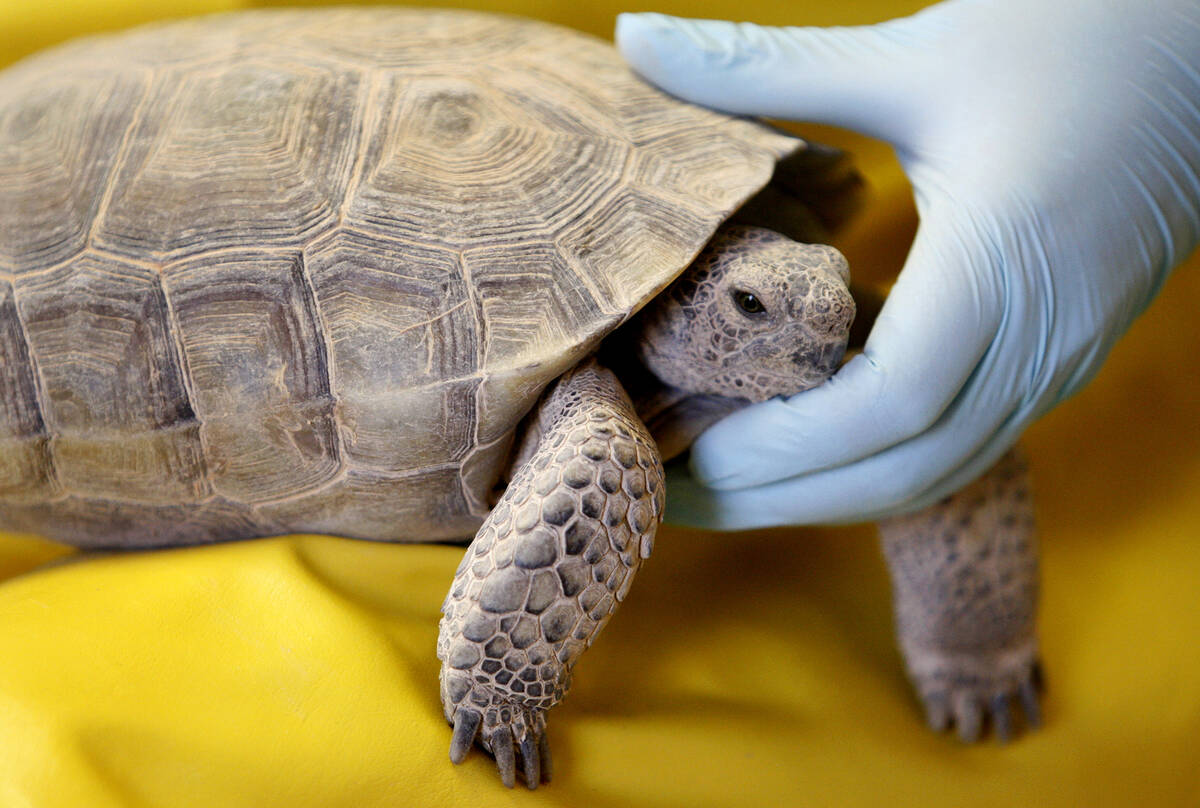What to do if you find a lost tortoise
If you have Ring or Nextdoor, you’ve likely seen one of your neighbors reporting a lost, or found, tortoise in your community.
Sarah Mortimer, executive director of Tortoise Group, Nevada’s sole tortoise adoption agency, said the group receives around 1,500 to 2,000 requests a year for help with lost and found tortoises.
She shared some tips on what you should do if you find a lost desert tortoise.
Step 1: Identify if the tortoise is wild or not
Sometimes, a tortoise is in the care of one of your neighbors, and sometimes, it’s just a wild tortoise.
If a tortoise is found on a job site or in the wild, Mortimer says the tortoise is a designated a wild tortoise. If the tortoise is wild, you should call Clark County’s Wild Desert Tortoise Assistance Line at 702-593-9027.
The county can pick up a tortoise free of charge, according to the county’s Desert Conservation Program.
Step 2: If the tortoise is a pet, try to reunite the tortoise with its family on your own first
Mortimer says once you’ve figured out if your tortoise is someone’s pet, you should try to reunite the tortoise with its owner yourself.
People who have lost or found a tortoise can list a tortoise on Tortoise Group’s Lost and Found page on their website. A form will ask for your phone number and email address so you can be contacted and help reunite a lost tortoise.
Mortimer also recommends people list lost tortoises on neighborhood apps, social media and on Tortoise Groups’ Facebook page, and include where the tortoise was found.
“It is a lot more work to go through putting it through our programs to be adopted out (than) if we can just reunite it with its original home,” Mortimer said. “Tortoises are a part of people’s family, so we want to do our due diligence of reconnecting the two.”
Tortoises can also be microchipped. You can take the found tortoise to a local vet where they can scan the chip free of charge.
Step 3: Care for the tortoise in the meantime
While you’re waiting to find a tortoise’s home, there are things you can do to make sure the tortoise receives proper care.
Mortimer recommends people house their found tortoise in a spare bedroom, laundry room or bin that is escape proof. If you have time, you can let the tortoise roam outside under supervision during the early morning hours or in the evening to avoid them overheating.
“They do need to be kept indoors because if they don’t have a burrow to avoid the hottest temperatures,” she said.
You can also buy special tortoise food for the tortoise, or, if you’re in a bind, you can feed them lettuce, kale or dandelion greens. But, Mortimer said to not feed them lettuce long term because it doesn’t have many nutrients, and is only a water source.
Tortoise caregivers can also put the tortoise in a shallow dish with lukewarm water halfway up the shell, so the tortoise can drink if it wants to but still keep its head above water. (Remember: desert tortoises can’t swim.)
Step 4: If the tortoise is sick, bring it to a vet
There are several veterinarians with tortoise experience across the Las Vegas Valley, but Mortimer recommends Creature Comforts Animal Hospital or Aloha Animal Hospital as good go-to options for sick torts.
Step 5: If the tortoise isn’t reunited, you can either adopt or give to Tortoise Group
After exhausting all options to reunite the tortoise with its owner, you, a family member or friend can adopt your found tortoise with the help of Tortoise Group, or you join Tortoise Group’s waiting list of surrendered tortoises.
However, Tortoise Group has a one- to three-week waiting period for tortoises, as the agency is currently at capacity with juvenile and other surrendered tortoises.
Overcrowding causing waitlist
Backyard breeding is one of the primary factors contributing to Tortoise Group’s overcrowding problem, along with cases where people keep dozens of tortoises in their backyard at a time that are surrendered all at once, Mortimer said.
Once a tortoise is born in captivity, it cannot be released, in most cases, out into the wild due to the threat of spreading disease, and must be adopted out to a home, she said. Tortoise Group also only adopts out one tortoise per household to avoid fighting and mating between tortoises.
Tortoises outliving their owners is another contributor to overcrowding, she said. Desert tortoises in captivity can live to be 80 to 100 years old, according to the University of Arizona.
“That’s important, especially with a long-lived species like the tortoise to consider what is my game plan down the line, because this animal is likely to outlive me,” she said. “It becomes a bigger issue when you’re keeping 40 or 50 tortoises in your backyard that are all probably going to outlive you.”
Preventing rogue tortoises
Tortoise owners can take steps to ensure their tortoise doesn’t go missing.
Besides creating a secure habitat that a tortoise can’t escape from, owners can print out their phone number or write it down with a fine tipped pen with dark, waterproof ink and apply a sticker to their tortoise with clear epoxy.
You must avoid seams in the shell to attach the number, or else it can cause deformity for the tortoise as it grows. For more detailed steps, visit tortoisegroup.org/marking-your-tortoise.
Tortoises over 7 inches long can be microchipped, but Mortimer said a phone number is much more likely to reunite a tortoise with its family.
For other tips on tortoise care, you can look at the group’s online care sheets that give advice on anything from how to build a proper habitat to a list of plants that are poisonous for tortoises.
Contact Taylor Lane at tlane@reviewjournal.com.

















